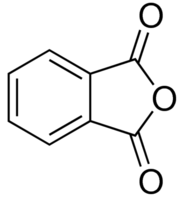Phthalic Anhydride

Product Description
Phthalic anhydride is an organic compound with various industrial applications.
Product:
Phthalic Anhydride
CAS:
85-44-9
Synonym:
1,3-Isobenzofurandione; 2-hydroxyimidazole
Structure:

Typical Characteristics
Appearance
White crystalline powder
Boiling point
284 °C
Density
1.53 g/cm3
Flash Point
152 °C
Melting point
131 - 134 °C
Molecular Weight
148.12
Odor
Characteristic, acrid odor
Purity
≥ 99 %
Refractive index
1.646
Uses, Applications & Markets
Key applications
get a quote
We Offer Phthalic Anhydride
in various grades
A few of the grades available are listed below:



Phthalic Anhydride used in many
industry applications
Phthalic anhydride is an organic compound with various industrial applications. Here's a list of some of its uses:
- Plasticizers: Phthalic anhydride is a key raw material in the production of phthalate plasticizers, such as diethyl phthalate (DEP) and dibutyl phthalate (DBP). These plasticizers are added to polyvinyl chloride (PVC) and other polymers to impart flexibility, durability, and resilience to the final plastic products, including vinyl flooring, cables, and automotive parts.
- Alkyd Resins: Phthalic anhydride is used in the synthesis of alkyd resins for paints, coatings, and adhesives. It reacts with glycerol or other polyols and fatty acids to form alkyd polymers with excellent film-forming properties, adhesion to substrates, and weather resistance. Alkyd-based coatings are widely used in architectural, automotive, and industrial applications.
- Unsaturated Polyester Resins (UPR): Phthalic anhydride is a primary ingredient in the production of unsaturated polyester resins (UPR) for fiberglass-reinforced plastics (FRP) and composites. It undergoes condensation polymerization with glycols, such as propylene glycol or ethylene glycol, and styrene to form UPR, which can be molded into various shapes and structures for construction, marine, and transportation industries.
- Phthalate Esters: Phthalic anhydride is utilized in the synthesis of phthalate esters, which find applications as solvents, lubricants, and plasticizers in various industrial processes. These esters are also used as carriers for pesticides, herbicides, and fragrances, as well as in personal care products, such as cosmetics, perfumes, and lotions.
- Phthalocyanine Pigments: Phthalic anhydride is a precursor in the synthesis of phthalocyanine pigments, which are widely used in printing inks, paints, and coatings for their intense color, lightfastness, and chemical stability. These pigments are employed in graphic arts, packaging, textiles, and consumer products to achieve vibrant and durable coloration.
- Flame Retardants: Phthalic anhydride is used in the production of flame retardants for plastics, textiles, and construction materials. It reacts with aromatic amines or alcohols to form phosphorus-containing flame retardants that inhibit the ignition and spread of flames, reducing the fire hazard and improving the fire safety performance of materials.
- Surfactants: Phthalic anhydride is employed in the synthesis of nonionic surfactants for detergents, emulsifiers, and wetting agents. It undergoes esterification or amidation reactions with fatty alcohols or amines to produce surfactants with excellent surface-active properties, dispersibility, and foamability for use in household, industrial, and personal care applications.
- Intermediates: Phthalic anhydride serves as a versatile intermediate in the production of various organic compounds, including dyes, pigments, pharmaceuticals, and agricultural chemicals. It undergoes further reactions, such as hydrolysis, oxidation, and nitration, to yield a wide range of valuable products with diverse applications in industries.